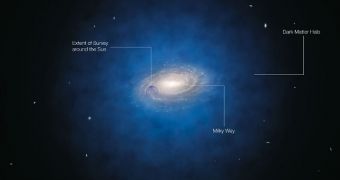In a finding that sheds doubt on the very existence of dark matter, researchers found no trace of the stuff in a radius of 17,000 light-years around the Sun. The solar neighborhood should have been filled with the elusive stuff, according to current theories.
The volume of space encompassed within the study “sphere” is enormous, and yet the normal, baryonic matter that can be observed within has enough mass to account for the motions of nearby stars.
The new investigation focused on analyzing the paths and speeds of 400 stars. By using the FEROS spectrograph on the MPG/ESO 2.2-meter telescope, experts were able to collect some of the most detailed measurements to date on these objects.
They found that the matter contained within the studied volume exerted the exact gravitational force that was detected by analyzing stellar motion. If dark matter filled this space, then gravity should have acted more intensely.
Thought to be made out of so-called Weakly-Interacting Massive Particles (WIMP), dark matter does not interact with baryonic matter, except by exerting a gravitational pull on it. What the new study suggests is that the stuff is simply not present in the solar neighborhood.
The study was conducted by experts from Chile, using the European Southern Observatory's (ESO) La Silla facility. It covered a region of the sky more than four times larger than any previous research.
“The amount of mass that we derive matches very well with what we see – stars, dust and gas – in the region around the Sun,” says Universidad de Concepción Departamento de Astronomía scientist and study team leader, Christian Moni Bidin.
“But this leaves no room for the extra material – dark matter – that we were expecting. Our calculations show that it should have shown up very clearly in our measurements. But it was just not there!” he adds.
The team warns that the new results do not represent conclusive evidence that dark matter does not exist. “The Milky Way certainly rotates much faster than the visible matter alone can account for,” and this is evidence to support the idea that the stuff is indeed there, Bidin explains.
“So, if dark matter is not present where we expected it, a new solution for the missing mass problem must be found. Our results contradict the currently accepted models. The mystery of dark matter has just become even more mysterious,” the Chilean investigator concludes.

 14 DAY TRIAL //
14 DAY TRIAL //